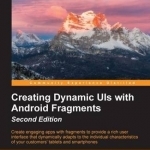Creating Dynamic UI with Android Fragments
BookThis item doesn’t have any media yet
2016 | Computing & IT
Create engaging apps with fragments to provide a rich user interface that dynamically adapts to the individual characteristics of tablets and smartphones About This Book* From an eminent author comes a book that will help you create engaging apps that dynamically adapt to individual device characteristics* The only book that includes the latest fragment-oriented features and their role in Material design* This book provides code-intensive discussions and detailed examples that help you understand better and learn fasterWho This Book Is For This book is for developers with a basic understanding of Android programming who would like to improve the appearance and usability of their applications by creating a more interactive user experience and dynamically adaptive UIs; providing better support for tablets and smartphones in a single app; and reducing the complexity of managing app UIs.
What You Will Learn* Learn the role and capabilities of fragments* Use Android Studio's fragment-oriented features* Create an app UI that works effectively on smartphones and tablets* Manage the creation and life cycle of fragments* Dynamically manage fragments using the FragmentTransaction class* Learn the application design for communicating between fragments* Leverage fragments when implementing applications that take advantage of the latest features of Material DesignIn Detail Today's users expect mobile apps to be dynamic and highly interactive, with rich navigation features. These same apps must look fantastic whether running on a medium-resolution smartphone or high-resolution tablet. Fragments provide the toolset we need to meet these user expectations by enabling us to build our applications out of adaptable components that take advantage of the rich capabilities of each individual device and automatically adapt to their differences. This book looks at the impact fragments have on Android UI design and their role in both simplifying many common UI challenges and in providing best practices for incorporating rich UI behaviors.
We look closely at the roll of fragment transactions and how to work with the Android back stack. Leveraging this understanding, we explore several specialized fragment-related classes such as ListFragment and DialogFragment. We then go on to discuss how to implement rich navigation features such as swipe-based screen browsing, and the role of fragments when developing applications that take advantage of the latest aspects of Material Design. You will learn everything you need to provide dynamic, multi-screen UIs within a single activity and the rich UI features demanded by today's mobile users.
Related Items:
| Published by | Packt Publishing Limited |
| Edition | Unknown |
| ISBN | 9781785889592 |
| Language | N/A |
Images And Data Courtesy Of: Packt Publishing Limited.
This content (including text, images, videos and other media) is published and used in accordance
with Fair Use.
